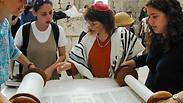
Women push for more shul participation
In Jerusalem synagogue, women already read from handwritten Torah scroll at separate service held about once a month. Now, some members also want them to be able to lead part of Shabbat service
In Kehillat Yedidya, a 200-household synagogue in Jerusalem’s Baka neighborhood, women already read from the handwritten Torah scroll at a separate women-only service held about once a month. They carry the Torah through the synagogue before and after that reading.
Now, some of the members also want women to be able to lead part of the Friday night service, a series of hymns called Kabbalat Shabbat or "welcoming the Sabbath." These hymns are usually sung aloud and are then followed by the evening service. According to Jewish law, or Halacha, since only men are obligated in three-times-daily prayer, only men can lead the daily morning, afternoon and evening prayers in synagogue before a minyan, a quorum of 10.
At a panel at Yedidya this week, three rabbis and an educator gathered to discuss whether women can lead the Kabbalat Shabbat prayers as part of its fact-finding before deciding whether to mandate a change in the synagogue’s custom.
"Something which is not forbidden is clearly permitted," said Rabbi Professor Daniel Sperber, the president of The Jesselson Institute of Advanced Torah Studies at Bar-Ilan University. "In this case, there is no reason that women cannot lead Kabbalat Shabbat."
Sperber says that women have made great strides in the workplace. In the past decade, many Orthodox women have spent years studying Jewish texts and have become well-educated.
"“Women find themselves in an untenable position and they feel a tremendous degree of inequality," Rabbi Sperber told The Media Line. "Where it is possible to give them a degree of spiritual satisfaction, it is our duty to do so. As someone involved in the Halacha and the history of Halacha, you see it is constantly changing and offering solutions to problems."
Other panelists disagreed.
"I would not go to a synagogue where women lead Kabbalat Shabbat,” Rabbi Shlomo Vilk told the panelists. “I believe in separation of the sexes, and not crossing the barrier between them. Why can’t women hold a separate service for themselves, not with the men?"
'Slippery slope'
There is a precedent for this. In Eastern Europe in the 17th and 18th centuries there was something called a "weiberschul" or "women’s synagogue," a separate building attached to the men’s synagogue. Although many women were illiterate the prayers were led either by men or educated women, usually in Yiddish.
"The leader would tell the women when to sit down, when to stand up, when to cry," Rabbi Sperber said.
Rabbi Shlomo Riskin, the chief rabbi of Efrat, a Jewish community built on land Israel acquired in 1967, who has also founded a series of educational institutions, offered a sociological response rather than a legal one.
"If many of the women are expressing sadness and real grief, and if the change is supported by a decisive majority in the synagogue, then you can make the change," Rabbi Riskin said. "You have to think about who would stay in the congregation and who would leave. If those who would leave would go to a Reform or Conservative congregation, that is another argument for making the change to keep them in the synagogue."
In most synagogues, the rabbi would make the decision. But at Yedidya, which doesn’t have a rabbi as a matter of principle, the decision will be made by the committee on Jewish law and custom after an extensive survey of the community. Yedidya, which was founded 20-years ago by English-speaking immigrants, prides itself on being at the forefront of allowing women’s participation within the confines of Jewish law.
But in recent years a new phenomenon called "partnership minyans" have become the cutting edge of custom within the community called "Orthodox," while some would argue that their practices remove them from that genre. In these prayer groups, while men and women continue to sit separately, both men and women can read from the Torah scroll and say the blessings that accompany the readings.
At the panel, Rabbi Riskin said he did not believe these gatherings were consistent with Jewish law, while Rabbi Sperber disagreed.
"Women want to hear women’s voices in the sanctuary and are looking for more ritual participation," Elana Sztokman, the execution director of the Jewish Orthodox Feminist Alliance (JOFA), told The Media Line. "I travel around the world and everywhere women are speaking out and surprised by how many other women feel the same way."
Admittedly, all of this change is happening in a very narrow sector of the population in Israel. Some 25% of Israelis define themselves as Orthodox, while the majority is either traditional or secular. Among the self-described Orthodox, there is a range from modern Orthodox to ultra-Orthodox. Since the ultra-Orthodox have high birthrates, their percentage is increasing.
Those opposing expanding ritual opportunities for women worry about the "slippery slope" – that allowing women to lead parts of the service would lead to demands for women to be recognized as rabbis, an idea that most of the Orthodox community rejects. Those supporting it say that women should be given every opportunity to express their spirituality that does not violate Jewish law.
Article written by Linda Gradstein
Reprinted with permission from The Media Line










